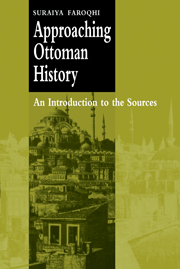Book contents
- Frontmatter
- Contents
- List of illustrations
- Acknowledgements
- 1 Introduction
- 2 Entering the field
- 3 Locating Ottoman sources
- 4 Rural life as reflected in archival sources: selected examples
- 5 European sources on Ottoman history: the travellers
- 6 On the rules of writing (and reading) Ottoman historical works
- 7 Perceptions of empire: viewing the Ottoman Empire through general histories
- 8 Conclusion
- References
- Index
5 - European sources on Ottoman history: the travellers
Published online by Cambridge University Press: 10 November 2009
- Frontmatter
- Contents
- List of illustrations
- Acknowledgements
- 1 Introduction
- 2 Entering the field
- 3 Locating Ottoman sources
- 4 Rural life as reflected in archival sources: selected examples
- 5 European sources on Ottoman history: the travellers
- 6 On the rules of writing (and reading) Ottoman historical works
- 7 Perceptions of empire: viewing the Ottoman Empire through general histories
- 8 Conclusion
- References
- Index
Summary
Due to the work of Edward Said and his associates, the biases inherent in European writing on the Middle East have become obvious to many if not most practitioners in the field (Said, 1978). Given the large number of available Ottoman materials, some researchers might therefore envisage basing Ottoman history entirely on Ottoman sources. When dealing with certain topics, studies built almost entirely on local or else Istanbul-based evidence can in fact be undertaken. As an example, one might mention the tax assignments known as timar, a characteristic feature of the administration of the central Ottoman realm in the fifteenth or sixteenth century. Since outsiders had only a superficial knowledge of the system's working, their testimony can largely be disregarded. But in other cases, the information relayed by Venetian, English or French travellers and embassy personnel is so important that we cannot simply neglect it. After all, the Ottoman state of the fourteenth to sixteenth centuries defined itself as a state conquering infidels (Inalcik, 1973, p. 6). This means that close contact to Venetian merchants, Balkan princes, and occasionally even members of western European ruling houses existed from the very early phases of Ottoman history. A critical use of European sources thus constitutes a major challenge to the Ottomanist historian.
In this chapter we will discuss some of the problems raised by this situation, concentrating on narrative sources from the sixteenth to eighteenth centuries. In a second, much shorter section, our focus will be European archival materials, with Ottoman port towns of the eighteenth and nineteenth centuries serving as examples.
- Type
- Chapter
- Information
- Approaching Ottoman HistoryAn Introduction to the Sources, pp. 110 - 143Publisher: Cambridge University PressPrint publication year: 1999

